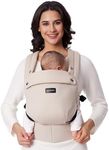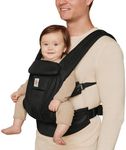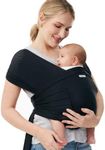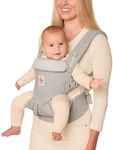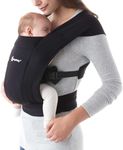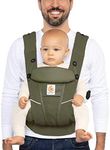Buying Guide for the Best Baby Carrier For Newborns
Choosing a baby carrier for newborns is an important decision because it affects both your baby's comfort and safety, as well as your own convenience and ease of use. The right carrier can help you keep your baby close, support healthy development, and allow you to move around hands-free. When shopping for a baby carrier, it's important to consider how it fits your body, how it supports your newborn, and how easy it is to use and clean. Understanding the key features will help you find a carrier that matches your lifestyle and your baby's needs.Carrier TypeCarrier type refers to the overall design and structure of the baby carrier, such as wraps, slings, soft-structured carriers, or mei tais. This is important because each type offers different levels of support, adjustability, and ease of use. Wraps are long pieces of fabric that you tie around yourself and your baby, offering a snug fit but requiring some practice to use. Slings are worn over one shoulder and are quick to put on, but may not distribute weight as evenly. Soft-structured carriers have buckles and padded straps, making them easy to use and comfortable for longer periods. When choosing, think about your comfort with tying or buckling, how long you plan to carry your baby at a time, and whether you want something quick to put on or more customizable in fit.
Weight and Age RangeThe weight and age range tells you the minimum and maximum size of baby the carrier is designed to safely hold. This is crucial for newborns, as not all carriers are suitable for very small or young babies. Some carriers are designed specifically for newborns, while others require an infant insert or adjustment to be safe for smaller babies. When looking at this spec, check that the carrier is approved for your baby's current weight and age, and consider how long you want to use the carrier as your baby grows.
Ergonomic SupportErgonomic support refers to how well the carrier supports your baby's hips, spine, and head, as well as your own back and shoulders. This is important for healthy development and for your own comfort. For newborns, the carrier should support the baby's head and neck and keep their legs in a natural 'M' position. For parents, wide, padded straps and a supportive waistband can help distribute weight evenly. When choosing, look for carriers that are recognized as 'hip-healthy' and try them on to see how they feel for both you and your baby.
AdjustabilityAdjustability means how much you can change the fit of the carrier to suit different body sizes and shapes, as well as your growing baby. This is important because a good fit ensures safety and comfort. Some carriers have multiple adjustment points for straps, seat width, and head support, while others are more fixed in size. If more than one person will use the carrier, or if you want it to last as your baby grows, look for a highly adjustable model. Try adjusting the carrier before buying to make sure it works for you.
Ease of UseEase of use describes how simple it is to put the carrier on, take it off, and place your baby in and out. This matters because you'll often be using the carrier when your hands are full or your baby is fussy. Some carriers are very intuitive with buckles or rings, while others, like wraps, take more practice. Consider your comfort level with learning new techniques and how quickly you want to be able to get your baby in and out.
Material and BreathabilityMaterial and breathability refer to the fabric used in the carrier and how well it allows air to flow. This is important for your baby's comfort, especially in warm weather or if you plan to wear the carrier for long periods. Some carriers use lightweight, breathable fabrics, while others are thicker and warmer. If you live in a hot climate or tend to get warm easily, look for carriers made from mesh or other breathable materials.
Cleaning and MaintenanceCleaning and maintenance describe how easy it is to wash and care for the carrier. Babies can be messy, so it's important to choose a carrier that is machine washable or easy to wipe clean. Check the care instructions before buying, and think about how often you'll need to clean the carrier based on your lifestyle.
